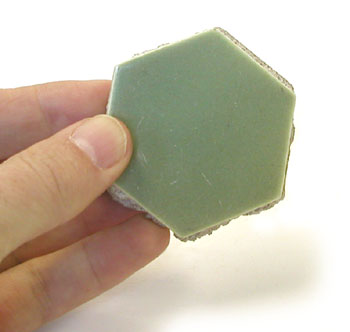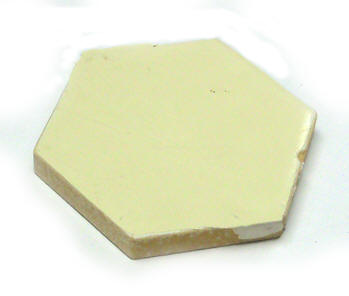Radioactive Tiles (ca. 1930s)
This particular piece of green tile (ca. 2" across) came from the bathroom of the president of Georgia State University.

Sometime in the 1980s, Bob Boyd, the Radiation Safety Officer at Georgia State University, was making radon measurements at the residence of the University's President. The residence was undergoing renovations at the time—to the tune of over $500,000 if I remember correctly. During the course of his work, Bob had to go to the bathroom. For the normal reasons, not to measure radon. In any event, he took his GM survey meter along with him and he had it turned on. After all, a meter that is turned off is nothing but dead weight. Just when he was getting comfortable, he noted that the GM's reading was unusually high. I believe he told me that it was something like 0.1 mR/hr, roughly ten times background. The source of the readings turned out to be uranium-containing tiles on the bathroom walls.

I don't know if the original intention was for the bathroom to be redone as part of the renovations, nevertheless, that's the way it turned out. The tiles were replaced and this is one of them.
Although it has that Avocado Green color that was so popular during the 1960s, I am guessing that the tile dates from the 1930s. An analysis of the tile indicates that the glaze contains natural uranium. This means that it almost certainly was produced before 1943.
The tile to the left (ca. 2.5" across) came from a bathroom in Los Angeles. It too contains uranium in the glaze.
Pertinent Nuclear Regulatory Commission (NRC) Regulations
The relevant NRC regulations, from Part 40 of Title 10 of the U.S. Code of Federal Regulations, are as follows.
"§ 40.13 Unimportant quantities of source* material.
(c) Any person is exempt from the regulation in this part and from the requirements for a license set forth in section 62 of the Act to the extent that such person receives, possesses, uses, or transfers:
(2) Source material contained in the following products:
(iv) Glass enamel or glass enamel frit containing not more than 10 percent by weight source material imported or ordered for importation into the United States, or initially distributed by manufacturers in the United States, before July 25, 1983."
The glass enamel mentioned in the regulation refers to the glaze used on tiles. As long as the uranium (essentially the mass of the U-238) constitutes less than 10 percent of the mass of the glaze, possession of the tile should not require a license.
* The NRC defines source material as follows:
"(1) Uranium or thorium or any combination of uranium and thorium in any physical or chemical form; or
(2) Ores that contain, by weight, one twentieth of 1 percent (0.05 percent), or more, of uranium, thorium, or any combination of uranium and thorium. Source material does not include special nuclear material."
The green tile was donated by Bob Boyd. The kind donor of the cream colored tile shall remain anonymous.
